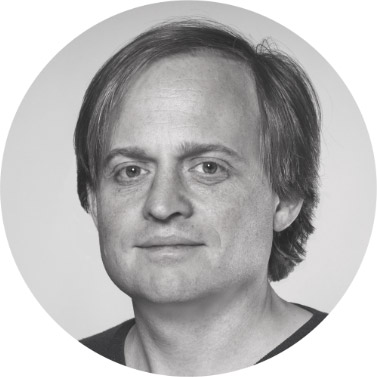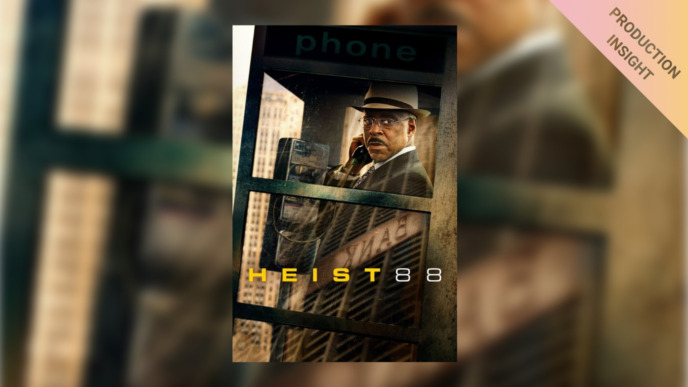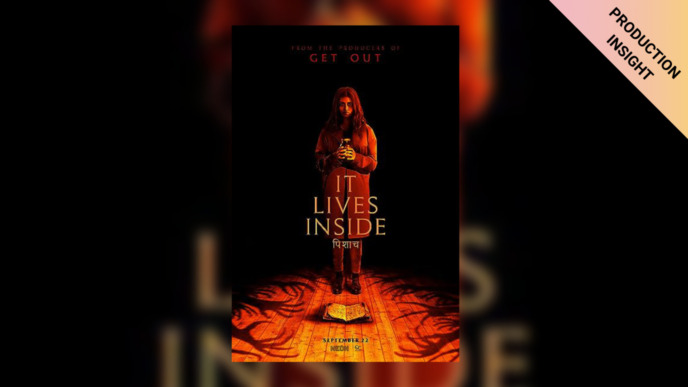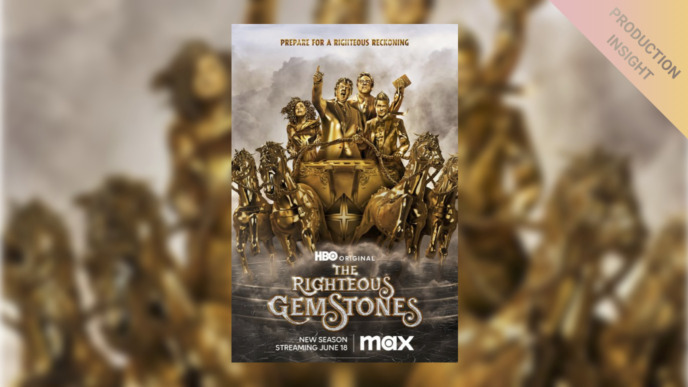
On large scale productions that span over several countries, consistency, in general, is always an important principle. Look consistency across different units is no exception here, especially when several DPs are involved – as it has been the case on “ZeroZeroZero”.
Earlier this year, we had already talked to the DITs of this TV series – Andrea Cuomo and Andrea Curiazi. They shared their experience of look management on set of this particular project. This time, together with DP Romain Lacourbas, we got to the bottom of the question, how the creative development of a picture can be visualized and improved by on-set grading with Livegrade.
In the following interview, he describes his perspective on the advantages of look previews. Besides, he gives many insights into his production workflow, which has enabled him to make his creative contribution to this TV series.
First of all, how are you, and how is the corona pandemic affecting your life?
I’m very well; thank you. Well, it’s affecting me like everyone, but I feel privileged just because I’m not living in a tiny apartment. I’m thinking about people who do live in very small places. Even though I live in Paris, I have a small courtyard, which makes a difference during this lockdown period.
For me, the pandemic was also the occasion to stay with my family. I usually spend a lot of time abroad for shoots. So it gave me the occasion to be very close to my family for a long time.
How it will affect our lives in the future is a very interesting question – for the next generation and for all of us really. I mean, we are all adjusting our life, and I think it’s about finding new ways of living together, even though that might be a naïve wish.
What about your professional life?
It stopped abruptly the same way everything shut down on the whole planet.
My last day of shoot was March 15th or 14th, I think. That day I was shooting in England for a TV show. I returned to Paris on the Eurostar. I was not scared, but I was not feeling really confident to be away from my family in those strange times.
I feel very lucky to be able to go back shooting now. I have a lot of colleagues here in France and in Europe who don’t know yet when their project will resume. I feel very lucky.
Can you tell us a bit about yourself?
I basically wanted to work in cinema since I was a teenager. But as most teenagers do, I wanted to become a director. So I started by learning arts at university and then I did another course in English at university again.
Then I entered a cinema school in Paris. It was a three years course, but after two years luckily I got employed as a trainee on a feature. The DP was Pierre Aïm, who did La Haine, which is one of the most well-known movies he did. Pierre probably shot about 90 or 100 movies. We became very close friends over the years, and Pierre told me everything about cinematography, conceiving, and lighting an image. So I discovered what cinematography was about during that first shoot. After a few weeks on set, I didn’t want to direct anymore. I just wanted to become a DP. Pierre was extremely sharing and generous and gave me the chance to step up as a second and first AC, later on as camera operator, and then as second unit DP. I was still working as an AC with other DPs, but most of the time, I was working with him.
That’s how, little by little, I started doing some short movies and shot five or six ones with Lola Doillon, who offered me to be DP on her first movie. That’s how it all started, basically. It’s really also about opportunities and who you meet and when you meet them. A few years later, I met Olivier Megaton, who needed a DP for Transporter 3’s re-shoots. We then started doing commercials and video clips together, and he offered me to do Colombiana.
That is basically how I got access to the US market, if I may say so.
You said at some point you realized what cinematography is about, and you decided to become a DP. So what is cinematography about, and why did you make that decision?
I realized that you have endless possibilities, as a cinematographer, of telling a story and helping a director to tell a story by composing a frame and setting up a visual style that justifies and supports the storytelling in a way. And being on a set is a fascinating experience as you’re constantly in the cradle of the fabrication of a movie.
You recently used Livegrade for the shoot of ZeroZeroZero, a series about international drug trafficking. I can imagine it will be hard for the production team to plan a new season with global shooting locations, given the current circumstances. Is there already a solution in work, and how do you think the new situation will affect shootings like these in general?
Very good question. I don’t know if they have the idea of making a second one, even though there are some rumors circulating. I’m sure the current situation would obviously affect a show of this kind. It wouldn’t be possible to shoot it the same way in the near future. At least in the next year. I don’t see how you could fly a whole crew and equipment and a whole production over four or five continents. I don’t see that happening.
My hope is that at some point we’ll be able to go back to those kinds of shoots. On the other hand, it also can be very inspiring for directors, writers, and DPs to tell stories in another way, with another grammar. I mean, how do you tell a story when you basically need to change your approach drastically, and you’re not able to shoot with 200 extras, for instance. Is it about writing a new story? Is it about shooting differently? Is it about using more VFX? It could be very restrictive if we were suddenly not allowed to shoot a kissing scene and had to do a multi-pass of one actor and then the other one against green screen – that could become boring. But it could also bring up new ideas: How to shoot a love scene without seeing people kissing each other, for example – trying to find a way to keep what’s good about it. The arts moving forward. And if it keeps something interesting and fun to watch, I think it’s the only way to approach those constraints right now. Because we just don’t have a choice, really.
The rules on set depend on which show you are working on.
I’m currently shooting in the UK, and we have extremely strict and precise rules in order to have a set running. Temperature check every day, testing the whole crew, etc.
Everyone needs to wear a mask and apply rules for social distancing. This, of course, changes the way a crew communicates with each other. It also means that each department is not able to work at the same time on set. All the different departments need to work one after another. Adding to this, cleaning the gear every day. Those are massive changes.
So it’s really about logistics, organization, and discipline. People need to use their common sense to implement these rules properly while still being efficient. It slows down the pace a little bit, and eventually, the schedules need to be extended accordingly.
In Europe, on-set color grading and look management is still a lot less used compared to the US. When and why did you decide to use it? What is different compared to conventional workflows?
I used Livegrade for the first time in 2014 for the shooting of Marco Polo. When I came to ZeroZeroZero, Paolo Carnera and Stefano Solima had already started shooting, and Paolo had already established a workflow for the show: Using a DIT and a close collaboration with Flat Parioli which was the lab in Rome, with the colorist Red overseeing all the dailies. The genius Red, as I like to call him. So that was all established when I joined the show and the adventure.
Except in commercials, some projects for streaming platforms, TV shows, and big features, it is very true that we use DITs less often in Europe. It’s not an automatism to use a DIT as it is in the US or the UK.
But I think this is slowly changing. I guess it’s also a matter of budgets. It’s a cost obviously to have a DIT with a whole DIT kit and everything.
How is it different from “conventional” workflows? It’s much more comfortable! Just because you are able to see and to show on set something as close as possible to what you have in mind and what you intend to do during the final grade. I think that’s the main difference.
What are the benefits of using on-set color grading and look management as a DP?
It comes to two main things. The first one is precision and accuracy, which means being able to go more into details and to make choices when you are on set. Radical choices possibly in a more safe way just because you’re looking at a pre-graded image. Because it’s pre-graded, you can go more into details. In a way, this also means time-saving for the final grade, where you would usually try these things.
It’s not about making an image completely different from the way you light it. But you can start playing a little bit with the colors here and there, and you just go deeper into things.
The second thing is, it’s more comfortable because you are able to show people – and most importantly the director – how it’s going to be and make sure that she/he likes it. That’s very comfortable! And it’s also very pleasant to be able to make sure how the dailies are going to look like. That is time-saving as well because the lab gets the show LUTs, but they also get the CDL. So, in theory, if all monitors are calibrated the same way, on set and at the lab, even if the color space is different, in theory, that should be the same. So it’s very reassuring, just because you know how the dailies are going to look like.
What was your creative intent regarding the cinematography of ZeroZeroZero? What were the challenges, and how did Livegrade help to achieve your goals?
Paolo started with Stefano for the first two episodes, and then I started episodes three, four, and five with Janus Metz. One of my goals – and I think it was the same for Janus – was to keep a visual continuity with what Paolo and Stefano had established. Which is something I had never done before because I only worked on pilots or features. So it was a very interesting exercise as I really like Paolo’s work. It can be challenging – in a good way – to try working in a different way that you’re not used to, sometimes also with a different tool, but most importantly, having a different approach. So I learned a lot.
And then it also was a new director I had never worked with. Janus has a different sensibility, and he had a slightly different approach to telling the story. But there was also the necessity to keep the style of the show. So the most difficult but interesting challenge I was confronted with was this one.
In Janus’s blocks, we have some locations that are only shown in our episodes. Senegal, for example, and some places in Morocco. Janus and I really wanted to give Senegal a different tone and push colors a little bit more and reach a stronger color separation.
You want to try to stay as close as possible to other cinematographers’ work, but you still have your habits. You still have things that you want to do in the way you’re used to. So you are trying to reach the same result in a different way. When you work as DP, the DIT, the camera op, or the AC’s and everyone working closely to cinematography would feel the difference because there are differences between Paolo and me. But I don’t think the audience will notice, which is interesting to see. We are keeping our differences in a way, but very few people would be able to see it.


For Senegal, we wanted to push the color and create a very distinctive visual aspect for it. It’s probably the location where I used Livegrade the most. As we wanted to push colors, secondaries, and saturation a little more, we went a little deeper into the Livegrade tools.
There was a scene in the nightclub at the end of episode 4, for example, that is extremely colorful. I was talking earlier about being precise. For instance, if you choose a colorful gel, a strong violet, or a strong blue or strong pink, and you start tweaking it just a little using Livegrade: If it washes the whole image or ruins the skin tones, then it’s not the right gel obviously. But basically, Livegrade is the only tool that can give you this information on set because otherwise, you discover those kinds of problems during the final grade.
Which cameras and lenses were used on the projects. Why did you choose this equipment?
We were on Alexa and master prime lenses. It was Paolo’s choice at the beginning of the show. I also like the Alexa because you’re in a kind of comfort zone. I’m usually more into funkier lenses. But I have to admit that when I showed up on set and when I joined the production, and I started looking at the dailies and the work of Paolo, I understood why he had chosen those lenses. It made complete sense to the storytelling for me. So I ended up liking the master primes for this show. I mean, every style needs to be relevant for the storytelling; the tools don’t really matter as long as they serve a purpose.
Does on-set color grading also influence lighting and exposure?
Lighting and exposure – of course! An important factor is using a LUT or designing a LUT before a show and committing to it. So the LUT gives you a direction, and then coloring on set gives you some more. It is one of a lot of parameters that you can modify and implement during the process.
Sometimes when you want to go heavy on colors, and you designed the LUT for it, when you light a very colorful dark scene, and you put on the blue gel that you think is going to react in a way, sometimes it just doesn’t react well at all! In such moments using Livegrade shows you if you can bring it back to where you were, and if you can’t, that means it’s not going to work. So you just change the gel. In this way, the choice of gels is obviously extremely influenced by the use of coloring on set.
The exposure is about the same. On a very dark scene, I tend to underexpose by closing the stop on the lens – to keep the idea of a strong direction during the shoot. What you see is what you get. To me, it is much more interesting than keeping everything safe.
So when you are really “on the edge”, and you’re really playing with shadows and darkness, it’s also useful to know what you will and won’t be able to bring back later – on the shadows, for example. And the same for the highlights, too. It gives you the ability to see and check what is still there on a very bright, grey sky or details on very bright walls. So it does influence the exposure as well. You make decisions according to what you see but also according to what you want to keep, even if you don’t want to show it at that moment.
How did the collaboration between DP, DIT, colorist, and the post house look like? How were the dailies done?
Red, the colorist, designed a LUT with Paolo for the show in preproduction, and they started the first episodes using this LUT. When I got on board, I used the same LUT in the beginning. Then at some point – before Senegal – I asked to get a slightly different LUT just because we wanted to push the colors a little bit more and interact with hue and saturation intensity, the general tone of the curve, and the look of those scenes.
So I asked Red to make a slightly different one, which he did. And with the help of Andrea Cuomo, the DIT, we made some testing regarding exposure and filters, et cetera. Then we sent our updates to Red in Rome, who did some tweaks and sent it back.
Andrea Cuomo, the DIT, was doing on-set color grading for every shot, and we were sending every single CDL to the lab. Red was balancing and refining a little more. And then he was sending me a still of each shot every night. I was either happy, or I was asking for minor tweaks that he then would apply to the dailies and putting it all on the server – A real smooth teamwork between Red, Andrea, and me.
Usually, I get a calibrated iPad from the lab to get to see the most accurate dailies as possible. As we were shooting in so many different countries very far away, that wasn’t possible.
I looked at the dailies through a server, which is usually quite compressed, so I trusted the stills and Red’s eye, which I never regretted!
Sometimes I had some modifications to make. I was communicating through emails every day to Red. At the end of every day, I sent a long email to him explaining what I’d tried to achieve, and he was doing the refining and the final grade. To be honest, ninety-five percent of the time, I had no comment when I was getting his stills because it was just looking great. The communication was very clear and fluid between Andrea, Red, and me.
We were all on the same page and communicating a lot – Real teamwork.
How does on-set look creation and high-quality preview influence the creative work with the director?
Wow. Well, it influences a LOT! If you work with a director whom you have worked with a few times before and you know each other very well, then it’s probably not so important to get a tool like this. Just because there’s trust and there’s knowledge of each other. But when you work with a director for the first time this kind of tool becomes suddenly a very important one! It’s very hard to describe an image with words. With this tool, you can show the image right away, and it then becomes easier to talk about it. It’s a communication tool. When you work with the director for the first time, I think it’s a kind of communication tool. It is a very useful technique.
Could you describe one typical shooting day of this project? And what was one special thing you remember in particular? Maybe a specific scene that you are proud of?

The typical day. That’s gonna be hard because – between you and me – this was the craziest show I’ve ever done, just because the logistics were so complicated. From a production standpoint but also a crew and a DP standpoint, just because of all those various locations, as almost nothing was shot on stage. Everything was in remote locations, very far away, in very realistic locations where these kinds of stories actually happen. You know, places like Monterrey, Calabria or Senegal, etc.
So, a normal day? There was no normal day on ZeroZeroZero. Every day was a challenge. It’s impossible to describe a normal day.
There was one day where I was nervous because we were shooting on a ship, one of those big ones that are carrying thousands of containers – 120 meters long, something like that.
It was the scene after Chris managed to extinguish the fire on board, and the ship is drifting in the middle of the ocean. One of the challenges was to make sure we were not seeing any lights from the coast, so we went quite far onto the sea. In the story, there is no more electric power on the boat because all the motors and generators took fire, so there is nothing that produces electricity anymore, which obviously means reproducing the sense of total darkness on board.
So the only way to light the scene was the classic way to emulate moonlight. But on those big ships, there is no way to bring a lighting crane. We managed to rig an HMI light on top of one of the big cranes that are usually used to charge and discharge containers. The only lamp that we could use was a 6K as the ship’s geny wouldn’t allow more, and it was really far away, like literally at the other end of the ship! I was hoping that it would be enough to push some moonlight into the bridge, which was about 80 to 100 meters away from the light. I had to push the camera to 2500 ISO, but it worked.
During the course of the scene, Chris (Dane DeHaan) is staying on the top of the bridge in total darkness, and because he has Huntington’s disease and ran out of his medications, he’s in a kind of delirium. But suddenly, he sees a flashing, rotating light from a rescue boat really far away and realizes it’s his last hope.


For some reason, it took us a while to be ready. When we started rolling cameras, really heavy rain started falling on us. And all the projectors that I had around the cabin had to be switched off for obvious safety reasons, but the only one that stayed on was that 6K. We couldn’t have access to it anymore, given the big storm upon us. We kept shooting, and it actually worked beautifully because we were feeling the rain through the backlight, and it felt like we were in the middle of a storm, which is almost impossible to feature without the help of SFX – except if you’re very lucky! I was praying for that 6K not to burn or to explode! It lasted the whole take. And it even lasted for the next shot, I think. So, we managed to get a scene that was even more dramatic and spectacular because it was raining all around us. With only one remaining light and the feel of rain and storm! It was one of those happy accidents, happy surprises that sometimes happen – Just another day on ZeroZeroZero.

____________________________
Big ‘Thank You’ to Romain for letting us be part of this exciting project!
Romain Lacourbas, DP
Romain Lacourbas is a DP based in Paris, France. After initially wanting to become a director, the path eventually led him to cinematography, in which he finally discovered his passion. Meanwhile, he can look back on years of experience and several notable projects (e.g., ZeroZeroZero, Marco Polo, Colombiana, Taken 2). He mainly works on feature film and commercial projects.



